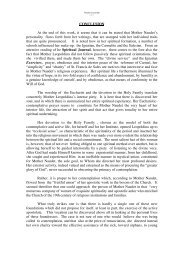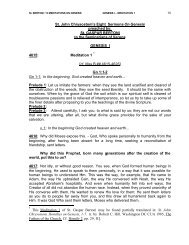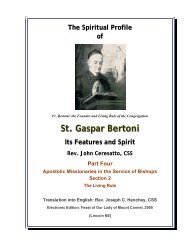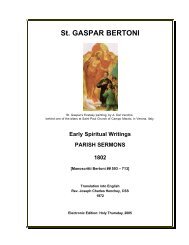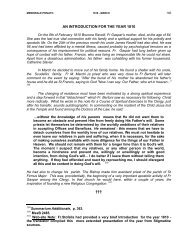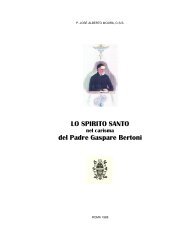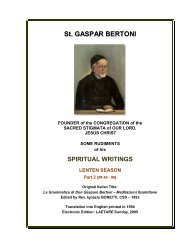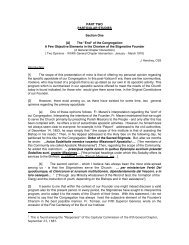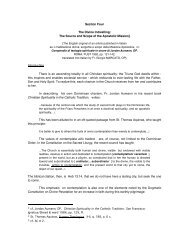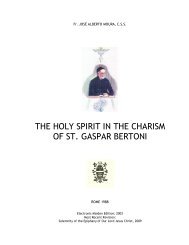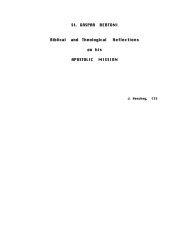[B.] St. IGNATIUS of LOYOLA Presentation: The ... - St. Gaspar Bertoni
[B.] St. IGNATIUS of LOYOLA Presentation: The ... - St. Gaspar Bertoni
[B.] St. IGNATIUS of LOYOLA Presentation: The ... - St. Gaspar Bertoni
You also want an ePaper? Increase the reach of your titles
YUMPU automatically turns print PDFs into web optimized ePapers that Google loves.
INTEGRE;SJ-OFM<br />
= 13 =<br />
[3] It is simply a very noble reality that the Redeemer <strong>of</strong> the<br />
World should have visited His own Mother before coming to anyone else, and before anyone else<br />
would have been able to rejoice in His Resurrection. And even though this maternal appreciation<br />
was hidden from the Evangelists, with all firm piety it is believed and held for certain in the entire<br />
universal Church, according to Ludolf.<br />
[4] <strong>The</strong>re is nothing unusual about the fact that not one <strong>of</strong><br />
the Evangelists has written anything about this appearance to Mary, because as <strong>St</strong>. John himself<br />
has stated, not everything about the life <strong>of</strong> the most holy Redeemer has been recorded. However,<br />
we can say that this most holy appearance would have taken place because his whole purpose<br />
in writing the 4th gospel was to note the witnesses <strong>of</strong> Jesus’ Resurrection. It would simply not<br />
have been fitting to draw the Mother into this with other witnesses, simply to prove the glory <strong>of</strong><br />
her Son. He left this appearance in the realm <strong>of</strong> the mystery in which it occurred. Nothing is<br />
present in the Scriptures that is without purpose. And there would be no need to mention this<br />
appearance which would have been evident in itself. He simply appeared to His Mother as her<br />
Risen Son, to bring joy to her heart through the vision <strong>of</strong> this Encounter.<br />
b.] Because <strong>of</strong> his references to her, <strong>St</strong>. Ignatius places this first <strong>of</strong><br />
all in his presentation <strong>of</strong> the Resurrected Christ. It stands to reason that for the Jesuit Founder<br />
this appearance would have been <strong>of</strong> primordial importance. He made use <strong>of</strong> none <strong>of</strong> the<br />
apocryphal sources, but simply placed this appearance to Mary as something self-evident,<br />
necessary and fundamental <strong>of</strong> all that will follow.<br />
c.] Regarding the space accorded to this appearance <strong>of</strong> the Risen<br />
Son to His Blessed other, there are two observations to be made:<br />
- in the first place, the appearance to Mary occupies and recurs in the Ignatian text as<br />
ending that ‘Paschal Hiatus’ [between the Burial and His Appearance], up until that moment in<br />
which the divinity <strong>of</strong> her Risen Son would appear to her as the principle <strong>of</strong> all life;<br />
- secondly, this appearance is included in the Preamble <strong>of</strong> the Fourth Week and becomes<br />
its fundamental hinge. This logically is the point that will lead to the structuring <strong>of</strong> the rest <strong>of</strong> the<br />
contemplations which will take place as the Fourth week progresses.<br />
[1] It needs to be noted that the “Paschal Hiatus” evident in<br />
Ignatius’ works depends upon this. in the SE # 208, <strong>St</strong>. Ignatius describes the “Sixth Day” <strong>of</strong> the<br />
Passion: At midnight, from the taking down from the cross to the burial exclusive [SE # 298], and<br />
in the morning <strong>of</strong> the burial inclusive to the house to which our Lady retired after the burial <strong>of</strong> her<br />
Son.<br />
[2] Throughout Holy Saturday, Our Lady spent this in<br />
solitude. <strong>The</strong> “Composition <strong>of</strong> Place” as part <strong>of</strong> the Ignatian spirit <strong>of</strong> prayer <strong>of</strong>fers for the<br />
contemplation <strong>of</strong> the Resurrection an imagination <strong>of</strong> the disposition <strong>of</strong> the sepulcher, and the<br />
house <strong>of</strong> the Blessed Virgin. When the Blessed Mother returned to the sepulcher and there<br />
Christ appeared to her.<br />
[3] In the presence <strong>of</strong> the Sorrowful Mother, the Sacred<br />
Body was taken down <strong>of</strong>f the Cross and placed in the monument. <strong>The</strong>n, Mary went home. Mary’s<br />
suffering is also that <strong>of</strong> the disciples <strong>of</strong> all times.<br />
d.] Throughout Tradition Mary is more than merely her physical<br />
person. She possesses a unique theological charge as Mother <strong>of</strong> Jesus. She fulfills a role in the<br />
History <strong>of</strong> Salvation which opened itself up more and more for <strong>St</strong>. Ignatius.<br />
[1] In the Spiritual Exercises, as well as in his life, Mary<br />
seems to appear in the crucial moments <strong>of</strong> his spiritual experiences:


![[B.] St. IGNATIUS of LOYOLA Presentation: The ... - St. Gaspar Bertoni](https://img.yumpu.com/33393889/13/500x640/b-st-ignatius-of-loyola-presentation-the-st-gaspar-bertoni.jpg)
